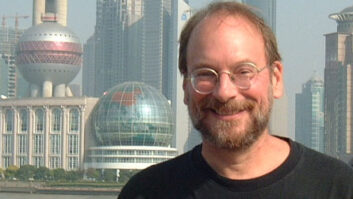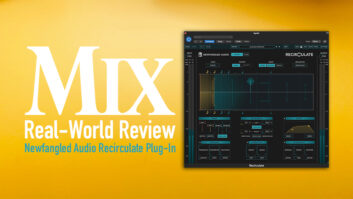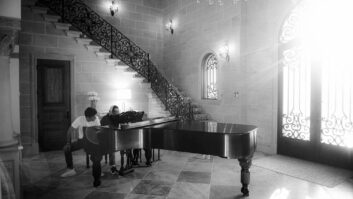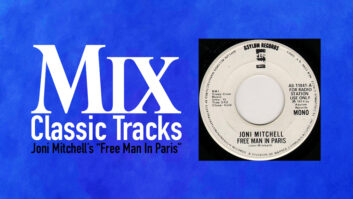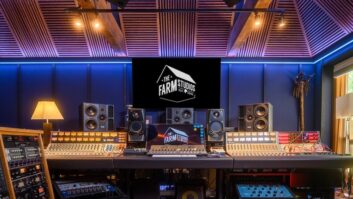With so much attention paid to new recording systems these days, it’s easy to forget that getting “your sound” is more than just what you print to tape, hard disk, MO or whatever your favorite recording medium happens to be. Signal processors may be far less glamorous recording tools, yet, unquestionably, they play a pivotal role in creating an overall sonic landscape. The past year has been a great one for digital signal processors. During this time, we’ve witnessed some truly impressive product introductions.
We decided to examine some recent new hardware products that handle reverb, delay, assorted multi-effects, vocal effects, mic and amp modeling, mastering and intonation chores. To ensure fairness, our “Parade of Stars” is listed here in alphabetical order, and a company contact section (with telephone numbers and Web sites) is provided if you need more information.
ANTARESUnless you were locked away in a dark cave, you couldn’t have missed the proliferation of microphones that have come to market in the past 18 months. Imagine having access to a “virtual locker” of impressive mics-without having to rent or borrow them. This is the premise behind the Antares AMM-1 Mic Modeler.
Using a proprietary technology called Spectral Shaping, Antares has created a series of digital models from AKG, Audio-Technica, beyerdynamic, Neumann and many others. As the company creates additional models of newly introduced microphones, those models will be available for download via the company’s Web site.
The modeling process is straightforward. You begin by telling the AMM-1 what microphone you are using (or what was used for a previously recorded track) and then tell the system which microphone you’d like it to sound like. Depending on the particular model, you also have control of various options such as low-cut filter, close/far proximity, windscreen, etc. It is also possible to add tube saturation.
BEHRINGERPriced at $599, the Behringer Ultra-Dyne(r) Pro DSP9024 is a 24-bit, dual-DSP 6-band dynamics processor designed for recording, live sound or mastering applications. This two-rackspace unit features 24-bit ADCs and DACs, programmable compressors, gates and a multiband exciter, with snapshot automation of all parameters. Onboard memory can delay individual frequency bands by up to 300 ms, allowing the unit’s 6-band compressor/gates and peak limiters to “anticipate” oncoming signals. Other features include an “Ultramizer” loudness function for optimizing outputlevels, “Virtuoso” program-adaptive compression, tube simulation andservo-balanced analog I/O with XLR and 11/44-inch connectors (AES/EBU digital I/O is optional). A free Windows-compatible editor for remote MIDI control will be available for download from www.behringer.com.
Also new from Behringer is the Ultramizer(r) Pro DSP1400P, a 24-bit digital compressor/leveler/loudness processor offering 2-band control in a $299 package with free Windows-compatible control software. In addition to its intelligent program-driven compression, the Ultra-mizer provides exciter, stereo surround functions and integrated single-ended noise reduction. It also includes internal 24-bit processing, 20-bit ADCs and DACs, servo-balanced analog I/O (XLR and TRS) and 50 user programs.
BOSSThe Boss VF-1 is a 24-bit multi-effects processor that can be used in performance, live sound and recording. The unit features reverb, delay, chorus and a number of dedicated guitar/keyboard/vocal effects. It also provides Roland’s proprietary COSM (Composite Object Sound Modeling) effects-derived from the company’s VG-8 V-Guitar system and V-Studio workstations.
The COSM effects found in the VF-1 include guitar amp and microphone modeling with comprehensive editing facilities for fine-tuning the effects. Incorporating 24-bit A/D and D/A converters and 30-bit internal processing, the VF-1 provides 400 sound patches (200 preset/200 user)-all accessible via the unit’s Category Search function. Preset patches range from guitar and bass multi-effects to keyboard and vocal effects, along with conventional reverbs, etc.
The half-rack Boss VF-1 provides a dedicated high-impedance guitar input, a built-in chromatic tuner and stereo input/output jacks with selectable-10dB/+4dBu operation for serial or parallel effects processing. The unit also features a coaxial digital output (allowing the unit’s output to remain in the digital realm during recording applications) and an extensive MIDI implementation for remote operation.
CARVINNew from Carvin is the XP4 effects processor with four 24-bit DSP engines that can be configured as quad mono, dual mono/single stereo or dual stereo pathways. In addition to simultaneously offering as many as four different effects from a palette of 100 factory presets (reverbs, chorus, phaser/flanger, delays and rotary speaker effects), the XP4 provides user memories for tweaking/storing custom settings from the front- panel controls or via MIDI, and effects can be internally patched to run in series or separately to its four 11/44-inch outputs. The XP4 lists at $595 but is available factory direct at $299; also available is the XP2, which is identical to the XP4, but in a dual-engine, $199 package.
dbxQuantum is a studio mastering tool that supports sampling rates up to 96 kHz with a true 48-bit digital signal path, combined with dbx dynamics processing. This dynamics processing is available in a 4-band, multiband system, whereby a four-way crossover splits the signal into the four individual bands. Each band can be individually gated, compressed and limited.
The Quantum employs dbx’s Type IV Conversion System, designed to provide a “big market” sound while retaining the warmth and body of the original analog signal. Combined with its Tape Saturation Emulation facilities, the unit is said to retain the overall sound of analog while providing the signal clarity required for digital music production and mastering.
Quantum’s menu-driven interface provides access to a complete set of mastering tools, including a 4-band crossover with independent slope selection; a 5-band parametric EQ with variable, adaptive or constant equalization; high and low shelving facilities; and compression, gating and limiting. Signals can be dithered down to 24, 20 or 16 bits using the unit’s dithering algorithms. For additional control, the Quantum has an extensive MIDI imple-mentation with internal and external synchronization capabilities.
DIGITECHThe DigiTech Vocalist VR is designed to provide vocal harmonies for live performance or recording applications. DigiTech claims the Vocalist VR is the only such unit capable of maintaining the characteristics of the human voice.
The Vocalist VR can generate two-, three-, four- or five-part harmonies, including the input voice. The unit lets users choose between chordal or scalic harmonies, select the key and scale, assign individual mix levels for the voice and harmonies, and add reverb and other effects. The unit’s lighted voicing switches provide a visual indication of whether harmonies are above or below the input voice, and effects can be added at the press of a button.
The Vocalist VR provides a balanced XLR mic input on the front panel and an unbalanced 11/44-inch line-level input on the rear panel. An auxiliary input allows for a direct feed to the reverb. There are also separate left/mono and right outputs with switchable -10dB/ +4dBu output levels. The processor provides a comprehensive MIDI implementation for remote control from a MIDI keyboard, sequencer or other controller. Additionally, the unit provides a footswitch jack for harmony and reverb bypass functions plus alternate key/scale switching.
DRAWMERAnother entry into the digital mastering arena is Drawmer’s DC2476 Digital Mastering Processor. Featuring both analog (balanced XLR) and digital (AES/EBU and S/PDIF) connections, the DC2476 is designed for recording and broadcast applications. The unit’s converters are 24-bit, and the digital output supports 16-, 20- or 24-bit word lengths at sample rates up to 96 kHz. Noiseshaped dithering is included, and word clock I/O is available.
The signal path of the Drawmer DC2476 has several distinctive stages, beginning with a dynamic EQ with full-bandwidth compression, followed by a 5-band EQ modeled on the response of classic analog filters. The input signal is then split into three user-definable bands and routed via a 3-band expander, a 3-band compressor, a 3-band limiter and a 3-band tube-modeled saturator. The three bands are then recombined and fed to the output stage via a fader system capable of generating precise fade-ins and fade-outs. The output stage also offers several dithering options.
The DC2476 provides an automated gain management system in the compressor and expander stages. This system monitors the signal level at critical points throughout the signal chain and reduces levels in situations when overloads would otherwise occur. Another notable feature of the DC2476 is its “Bootstrap” compressor, which increases the level of quieter signals while leaving signal peaks at original levels, as opposed to the more conventional process of reducing audio peaks. Drawmer claims this process makes it easier to adjust the individual bands of a multiband compressor, while, at the same time, eliminating the need to make constant adjustments to the gain control settings.
DYNATRONDistributed by G Prime, the Dynatron Model 255 Digital Reverb is a modern implementation of the classic EMT 250 algorithms developed by Karl Otto Bader and Dr. Barry Blesser. Unlike the original, however, the AES/EBU digital-only Model 255 comes in a two-rackspace chassis and features five reverb output channels, with initial reverb delay extended to 140 ms.
EVENTIDEEventide’s Orville builds upon the same 96kHz/24-bit sonic quality pioneered by the company’s UltraHarmonizer Series while taking the unit substantially further. Orville provides a large display with Eventide’s familiar keypad, knob and soft-key controls for easy access to the unit’s various programming parameters-aided by the inclusion of up/down/left/right keys for easy navigation. The unit has indicators for 96, 88.2, 48 and 44.1kHz sampling rates and includes an “EXT” digital stability LED.
Orville includes Eventide’s newest pitch-shifting technology-UltraShifter. The technology employs a four-octave range, and its adaptive re-synthesis capability facilitates extensive modification of vocal timbre. Orville provides hundreds of presets and is compatible with 99% of the effects available on the DSP4000/4500 plug-in cards. In addition to numerous reverbs, pitch shifters, distortions and other effects, the unit provides 4-channel reverbs for 360o surround-sound ambience.
Orville has extensive facilities for custom programming and offers remote control capability via MIDI. There are also provisions for two external footpedals or six footswitches. Orville supports up to four digital and four analog inputs and outputs. While each 4-channel processor (A and B) can be loaded/programmed independently, the unit also lets users configure the A/B processing relationship to facilitate signal processing in parallel, series or combinations of the two.
LEXICONUnveiled at Paris AES last month, Lexicon’s 960L offers advanced capabilities such as 24-bit/96kHz resolution, eight inputs/eight outputs, the ability to operate as two surround or four stereo processors and an all-new LARC2 remote with eight moving faders, joystick control and a large color display. For more information about the 960L, see the “Technology Spotlight” on page 106.
The Lexicon MPX 500 is a stereo, 24-bit dual-channel processor with balanced analog and S/PDIF digital I/O capability. The MPX 500 provides 240 presets with classic, true stereo reverb programs including ambience, plate, chamber and inverse, as well as tremolo, rotary, chorus, flange, detune, 5.5-second delay and echo. The unit’s dual-channel processing allows for independent effects on the left and right channels.
On the front panel, four dedicated knobs allow adjustment of four pages of effect parameters. There is a Learn mode that facilitates MIDI patching of front panel controls. The unit’s tempo-controlled delays can lock to Tap or MIDI clock, and Tap tempos can be controlled via audio input, the front panel Tap button, footswitch, external MIDI controller or MIDI program change.
Additional features include a graphics display, a software-selectable MIDI Out/Thru port, push-button or footswitch selection of dry or muted audio output, and a built-in power supply.
PEAVEYIn recent years, Peavey’s Architectural Acoustics Division has established itself as a leader in large-venue audio networking and distribution systems. The company’s MediaMatrix has become a very popular tool for managing audio in such environments. This year, Peavey AA introduced the MM-DSP-CN DSP card.
The MM-DSP-CN utilizes 24-bit processing and employs four Motorola 56002 DSP chips. The card operates at 168 MIPS, uses double-precision math and incorporates Peavey’s V-Stac processing technology for increased efficiency.
The MM-DSP-CN employs the company’s CobraNet technology using standard Ethernet. CobraNet allows for the transmission of multiple channels of audio over ordinary twisted pair cabling. The card provides 64 channels of I/O (32 input/32 output) on a 100baseT Ethernet network.
QUANTECWell-known for its ambience and room simulation effects, Quantec first established itself with the introduction of its Quantec Room Simulator (QRS) in 1982. A single-rackspace box that’s only 1.5 inches deep, the company’s new Yardstick 2402 or 2402/R (for remote operation) is a real eye-opener; it makes one wonder where the rest of the box is.
Following in the footsteps of its predecessors, the Yardstick takes ambience and room simulation effects into the digital domain. The original QRS algorithm, along with the Room Size and Enhance parameters, are now DSP functions. There is also a constant density mode for special effects. Bar graph meters for input and output levels are available on both the front panel and the remote control. The unit has no analog I/O but provides 24-bit stereo AES/EBU ports for direct signal and delay lines. The QRS algorithm requires a minimum 16-bit word length.
Saving and loading of user presets is accomplished via the RS-232 from a PC or via MIDI message. The Yardstick provides bypass and mute functions. An optional variable-edge brickwall high-cut filter is available for simulating the timbre of the original QRS’s 8kHz bandwidth.
ROLANDThe Roland SRV 3030 and 3030D digital multi-effect processors offer 24-bit resolution via their A/D and D/A converters and employ 30-bit internal processing. These units provide the full spectrum of digital effects including reverbs, the RSS (Roland Sound Space)3-D effect, flangers, chorus, phasers and resonators.
These processors employ Roland’s new Dynamic Separation Algorithm, which can separate signals and send them to independent reverb paths via its dual processor design. It is possible to define the variable by which the signal is split: dynamics, range or note density. As a result, a kick drum can be assigned a tight reverb while a snare is given a more spacious effect.
The SRV 3030 and 3030D provide three levels of editing: Direct (via physical knobs), EZ Edit for commonly accessed parameters and Custom Edit for more extensive work. The units provide a Preview Mode for auditioning effects. Other features include balanced XLR inputs and outputs and optional SmartMedia cards for memory storage. The SRV 3030D provides a coaxial digital output.
SONYThe DRE-S777 is unique in that it derives its sound from actual impulse response samples of real acoustic spaces as opposed to artificially generated algorithms. The DRE-S777 boasts 24-bit A/D and D/A converters, balanced XLR analog I/O (with the optional A/D/A board), AES/EBU digital I/O, MIDI implementation, and it supports RS-232 control and word sync I/O.
A mono in/stereo out (at 44.1 or 48 kHz) unit in its basic configuration, the DRE-S777 may be configured for 2-in/2-out and surround operations at 96 kHz with the optional DSP and A/D/A boards. The unit includes an integrated LCD, adjustable reverb time and pre-delay, and there is also an included CD-ROM with Plate, Spring, Hall and Church acoustic space models. Optional CD-ROMs are available for additional acoustic effects.
TC ELECTRONICTC Electronic’s System 6000 is a new tool for exploring the creative potential of multichannel audio. The modular-design Mainframe 6000 can be custom-configured, depending upon the needs of the individual user, and can also house as many as three additional I/O cards. This mainframe houses the fourengine DSP 6000 that has the ability to run four multichannel algorithms simultaneously. Each engine provides eight audio channels in and out (24-bit AES/EBU) that may be routed, cascaded, split and combined. Internal processing is handled at 48- or 72-bit resolution as needed.
The CPU 6000 serves as a communication module for the System 6000. This module runs in tandem with all Mainframe 6000s in the system. Communication is via Ethernet. USB connections facilitate the connecting of keypads, joysticks and other control devices. MIDI In and Out ports provide additional external control.
System 6000 can process audio in any format from mono to 7.1 and use internal/external sample rates from 32 to 96 kHz. Presets and algorithms include the VSS 5.1 multichannel/multisource room simulator, MD3 stereo or dual mono multiband dynamics processor, MD 5.1 multichannel/multiband dynamics processor and the TC Classics.
The M-One is a digital multi-effects processor providing reverb, chorus, tremolo, pitch, delay, dynamics and a number of other effects. The unit uses the company’s dual-engine design, which encompasses 24-bit A/D and D/A converters, S/PDIF digital I/O at 44.1 and 48kHz sampling rates, 11/44-inch jacks for dual I/O and 24-bit internal processing.
Based on the company’s successful TC2290 delay, the D-Two provides not only tempo tap but also rhythmic pattern entry. You can quantize to specific tempos or subdivisions, control the exact number of repeats with the unit’s Absolute Repeat Control function and specify repeats of up to 1 second each. There are 50 presets and 100 user locations. Delay may be programmed up to 10 seconds.
The D-Two uses 24-bit internal processing and 24-bit A/D and D/A converters. The unit includes S/PDIF digital I/O at 44.1 and 48kHz sampling rates and 11/44 -inch jacks for dual I/O.
The TC Electronic Intonator is a voice intonation processor aimed at reducing the tedious engineering task of redoing vocal takes. The unit provides pitch correction, de-essing, and adaptive low-cut filtering. The Intonator employs 96kHz internal processing with 24-bit resolution. Using a custom scale feature, the unit makes it possible to process individual notes. The Pitch Window allows you to specify when a note will be considered out of tune while the Amount parameter limits the amount of pitch correction processing.
The Intonator provides a word clock input for synchronization, digital connectivity to AES/EBU, S/PDIF, ADAT, a comprehensive MIDI implementation and a user interface with dedicated front panel and alpha dial controls.
The latest incarnation of this popular mastering processor, the Finalizer 96K now sports 96kHz processing with 24-bit resolution A/D and D/A converters. The unit’s sample rate converter accommodates a range from 31 to 49 kHz. There is also an ADAT interface that enables users to choose any two channels and redirect them to other channels. Additional digital format support includes AES/EBU, S/PDIF and TosLink.
The Finalizer 96K provides a 5-band, 24-bit stereo digital EQ, a real-time gain maximizer, a variable-slope multiband expander and a multiband compressor. Additional functions include dynamic EQ, Stereo Adjust, Digital Reference Generator and Spectral Stereo Imager. Normalization and dithering are also included.
WEISSThe second-generation Weiss DS-1MKII is a 96kHz de-esser/compressor that processes both input and output from 44.1 to 96 kHz in either mode. The unit employs 32-bit internal processing that is dithered down to 16/20/24-bit data, depending upon the subsequent equipment.
New features in the MKII version include a full-band crossover in Frequency Select mode, upward expansion to reintroduce dynamics in overly compressed signals and improved timing circuitry.

